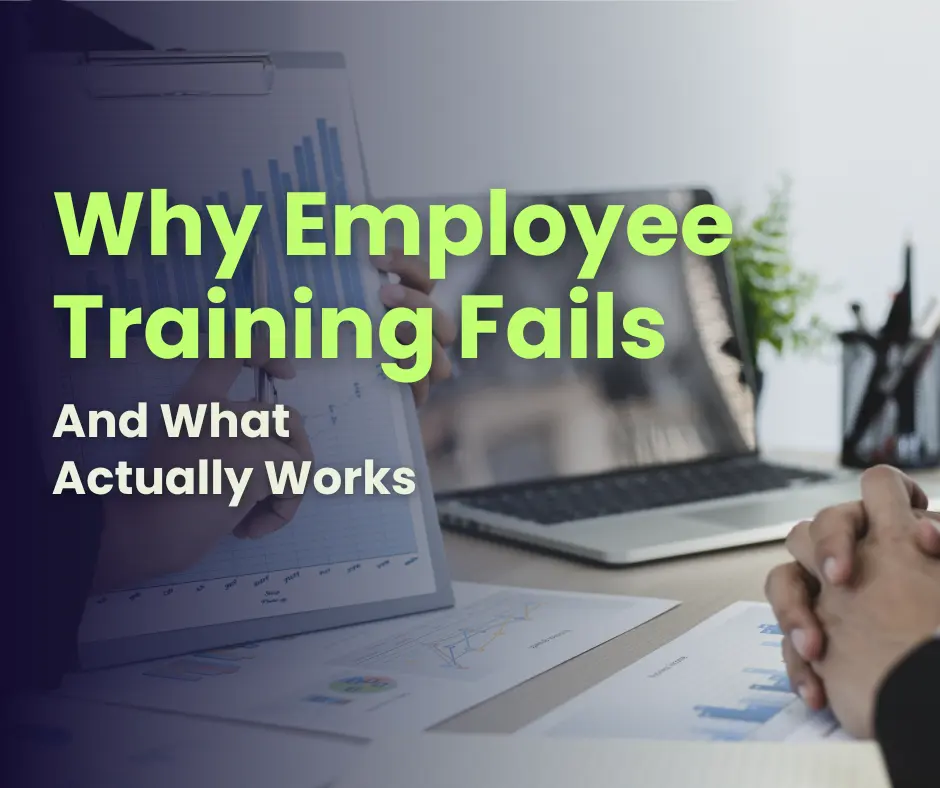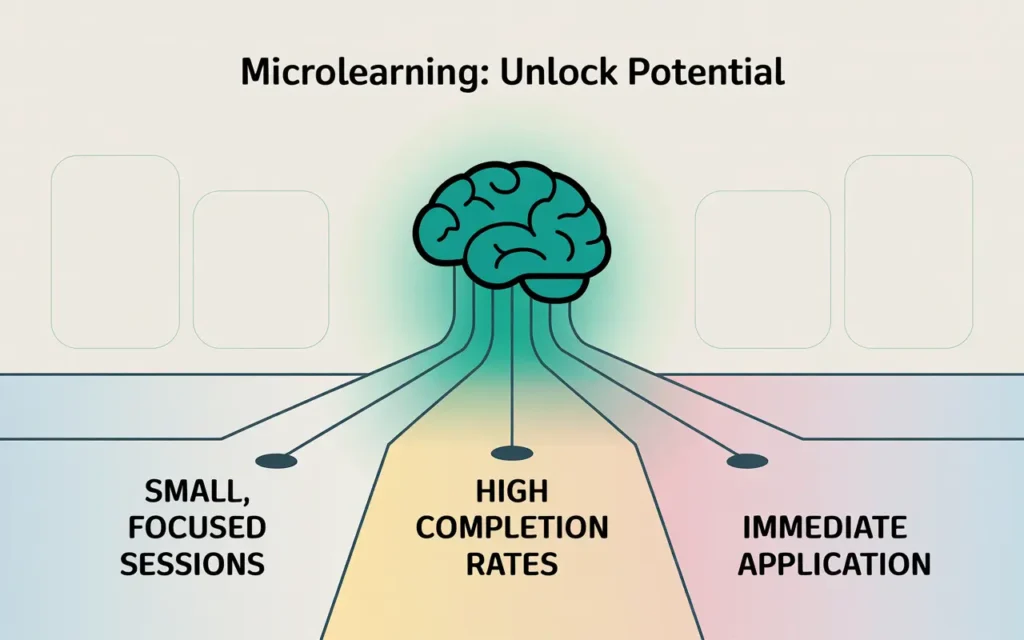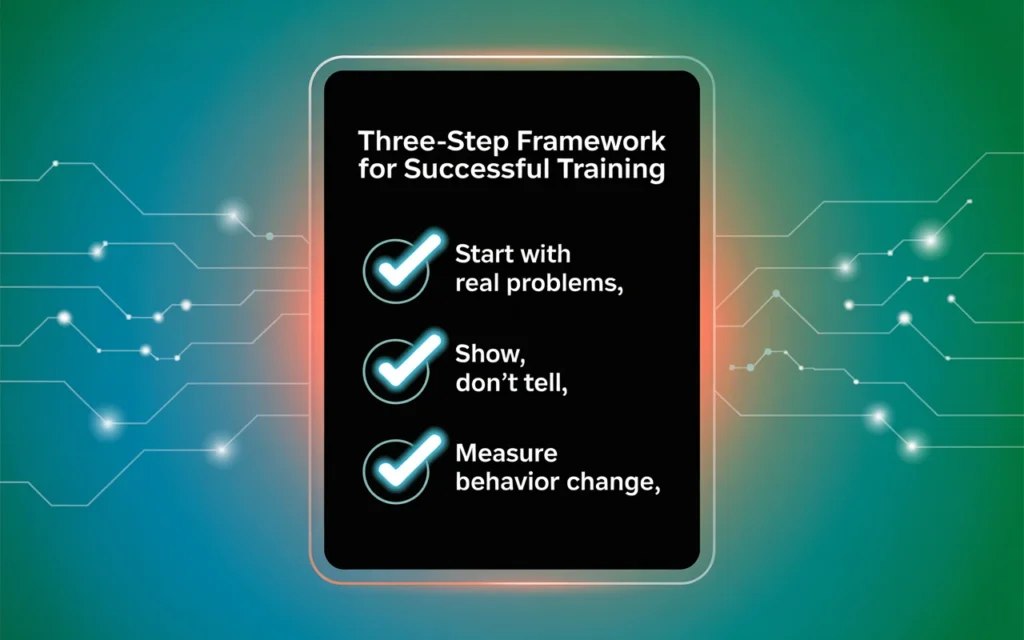
Let me guess.
You’ve invested in employee training this year. Maybe sent your team to a few workshops, bought some online courses, or hired a consultant to run sessions on “digital transformation.”
But here’s the uncomfortable truth: most of your people are still struggling with the same productivity bottlenecks they had six months ago.
I see this constantly when I work with companies across Southeast Asia. Leaders tell me they’ve “done training,” but their teams are still manually doing tasks that could be automated in minutes. They’re still overwhelmed by simple technology. Still resistant to change.
The problem isn’t your people. The problem is how we think about training.
In this post, I’ll show you why most employee training fails spectacularly, and the simple shifts that actually create lasting change in your organization.
The Training Theater Problem
Here’s what I call “training theater” – when companies do training that looks productive but changes nothing.
You know the type:
- Day-long workshops with 47 PowerPoint slides
- Generic “productivity” courses that don’t connect to your actual work
- Compliance training that checks boxes but builds zero skills
- “Digital transformation” sessions that never mention your specific tools
I watched a pharmaceutical company spend RM50,000 on “AI awareness training” last year. Three months later, not a single person was using AI tools in their daily work.
Why? Because awareness isn’t application.
Your people don’t need to understand how machine learning works. They need to know exactly how ChatGPT can help them write better emails or how automation can eliminate their most tedious tasks.
What Your Employees Actually Want (It’s Not What You Think)
The research is clear: 94% of employees would stay longer at companies that invest in their development. But here’s the nuance – they want development that makes their lives easier, not harder.
When I survey teams after my training sessions, the feedback is always the same:
- “I wish I’d learned this years ago”
- “This actually saves me time instead of adding more work”
- “Finally, training that connects to my real job”
Your employees aren’t asking for complex upskilling programs. They want practical solutions to everyday frustrations.
The shift? Stop thinking about training as education. Start thinking about it as problem-solving.
The AI Training Revolution Happening Right Now
Here’s something that might surprise you: the companies seeing the biggest productivity gains from AI aren’t the tech giants. They’re traditional businesses in Malaysia, Singapore, Thailand, and Indonesia.
But they’re not succeeding because they have better technology. They’re succeeding because they approach AI training programs differently.
Instead of teaching theory, they focus on immediate application:
- “Here’s how to write your monthly reports in 10 minutes instead of 2 hours”
- “This tool will handle your customer inquiries while you focus on complex cases”
- “Use this prompt to create your presentation slides instantly”
I recently worked with a logistics company in Kuala Lumpur. Instead of a broad “AI overview,” we focused on one specific problem: their teams were spending hours creating delivery route optimizations manually.
We spent two hours showing them how to use AI tools for route planning. Within a week, they’d cut planning time by 70% and improved delivery efficiency by 25%.
That’s the power of focused, practical training.
The Microlearning Secret That Actually Works

Forget the all-day training sessions. Your people are busy, and their attention spans reflect that reality.
The most effective training I deliver happens in 15-30 minute chunks spread over weeks, not hours crammed into a single day.
Here’s what works:
- Week 1: One specific AI tool for one specific task
- Week 2: How to integrate that tool into existing workflows
- Week 3: Troubleshooting common issues and advanced tips
- Week 4: Measuring results and sharing wins
This approach gets 85% completion rates compared to 20% for traditional long-form training.
Why? Because people can immediately apply what they learn before moving to the next concept.
The Southeast Asian Training Advantage
If you’re running a business in Southeast Asia, you have a unique opportunity right now.
Governments across the region are heavily investing in workforce development:
- Singapore’s SkillsFuture provides credits for business training
- Malaysia’s HRDF system supports comprehensive upskilling
- Thailand has allocated significant funds for AI initiatives
But here’s what most companies miss: this funding works best when training directly connects to business outcomes, not general education.
The key is positioning your training as a strategic business investment, not an employee benefit.

What Actually Drives Results: The Three-Step Framework
After working with hundreds of teams across different industries, I’ve found three elements that separate successful training from expensive theater:
1. Start with Real Problems
Don’t ask “What skills do we need?” Ask “What’s frustrating our people daily?”
I worked with a palm oil company where procurement teams were drowning in vendor evaluations.
Instead of generic “data analysis training,” we focused specifically on AI tools for supplier assessment.
Result: 60% faster procurement decisions.
2. Show, Don’t Tell
People learn by doing, not listening. Every training session should involve participants actually completing real work using new tools or methods.
3. Measure Behavior Change, Not Knowledge Retention
Stop testing what people remember. Start tracking what they actually do differently.
The Hidden Cost of Bad Training
Here’s something most leaders don’t realize: bad training doesn’t just waste money. It makes people more resistant to future learning.
When you send someone to a generic workshop that doesn’t help their daily work, you’re not just losing the training investment. You’re making them skeptical of the next training opportunity.
I see this constantly – teams that have been “trained to death” with little practical value become cynical about any new learning initiative.
The solution? Start small, prove value, then expand.
How to Choose Training That Actually Works
Before investing in any employee development, ask yourself:
- Will participants leave with a specific skill they can use immediately?
- Does the training address real frustrations your team faces daily?
- Can you measure the business impact within 30 days?
- Is the trainer experienced with businesses like yours?
If you can’t answer “yes” to all four questions, keep looking.
Your Next Steps
Employee training doesn’t have to be complicated or expensive to be effective. But it does need to be practical, focused, and immediately applicable.
Start with one specific problem your team faces. Find training that directly addresses that problem. Implement immediately. Measure results.
Then, and only then, expand to other areas.
Remember: your people want to be more productive and effective. They just need training that actually helps them get there.
What I’m Seeing Work Right Now
The most successful training programs I’m running in 2025 focus on practical AI integration for business-specific functions:
- Customer service teams learning to handle 3x more inquiries with AI assistance
- Finance teams automating their monthly reporting processes
- Sales teams using AI to personalize proposals at scale
- Operations teams streamlining workflows with intelligent automation
The common thread? Every session starts with a real business problem and ends with a working solution.
That’s how you create training that people actually value – and that drives measurable business results.
Looking to implement practical AI training that actually drives results? I, David Hooi, help Southeast Asian businesses transform their operations through focused, outcome-driven training programs. Let’s talk about your specific challenges.

